Delay Analysis and Its Effects on the Construction Industry
VerifiedAdded on 2023/06/07
|9
|2281
|242
Report
AI Summary
This report provides a comprehensive analysis of delay analysis and its effects on the construction industry. It begins by introducing the significance of the construction sector and the critical issue of project delays, highlighting the financial and reputational consequences. The research questions focus on defining delay analysis, identifying factors causing delays, and assessing the overall impact on the construction industry. The aim is to investigate the effect of delays on project execution and completion, with objectives including understanding delay analysis methods, assessing delay factors, analyzing the effects of delays, and recommending suitable approaches to minimize these issues. The literature review covers various delay analysis methods such as time impact analysis and window analysis, alongside factors like stakeholder conflicts, inefficient management, labor shortages, and material unavailability. The report concludes by outlining the qualitative research methodology employed, including the research approach, philosophy, data collection, and ethical considerations, while acknowledging limitations such as time and resource constraints. Desklib provides access to this report along with a wide range of study resources for students.
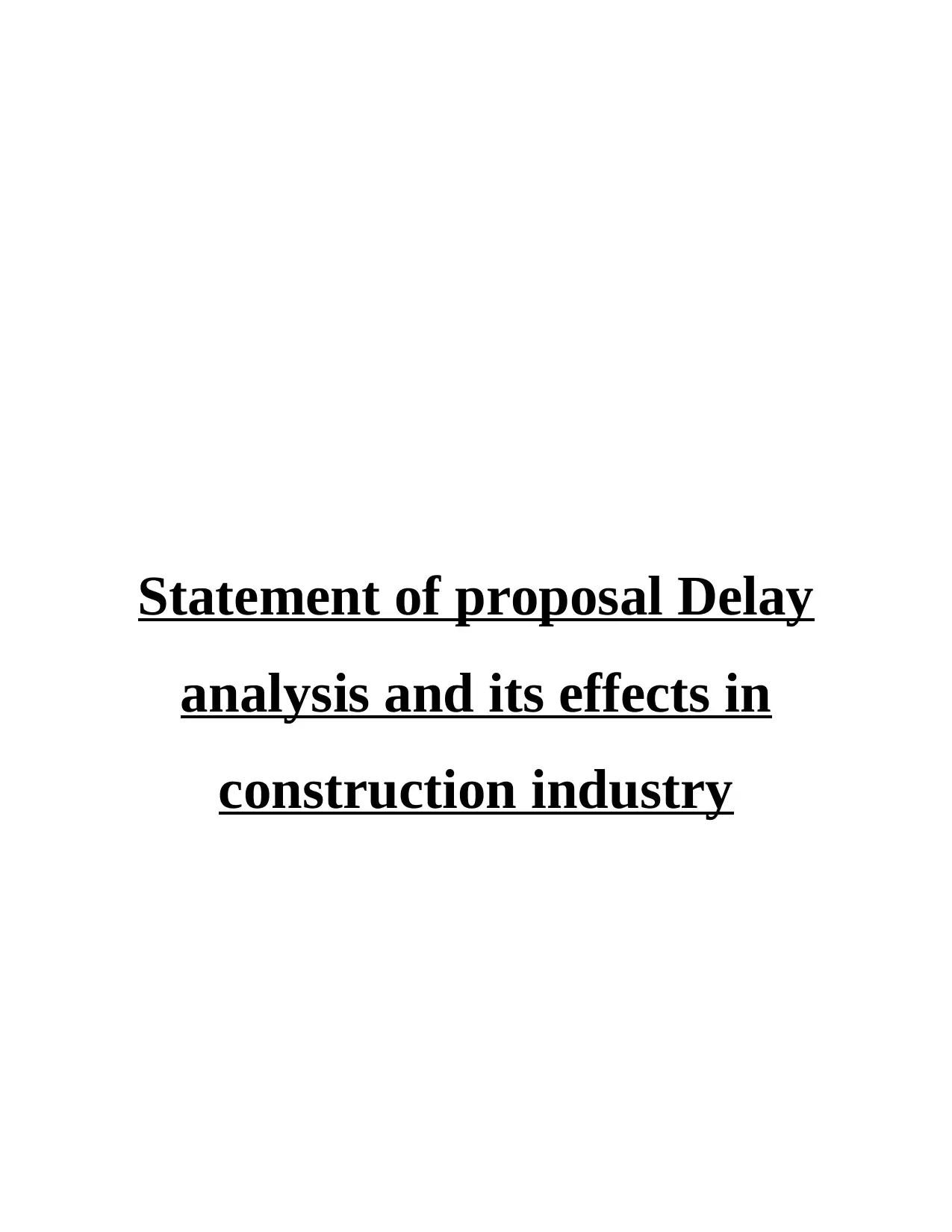
Statement of proposal Delay
analysis and its effects in
construction industry
analysis and its effects in
construction industry
Paraphrase This Document
Need a fresh take? Get an instant paraphrase of this document with our AI Paraphraser
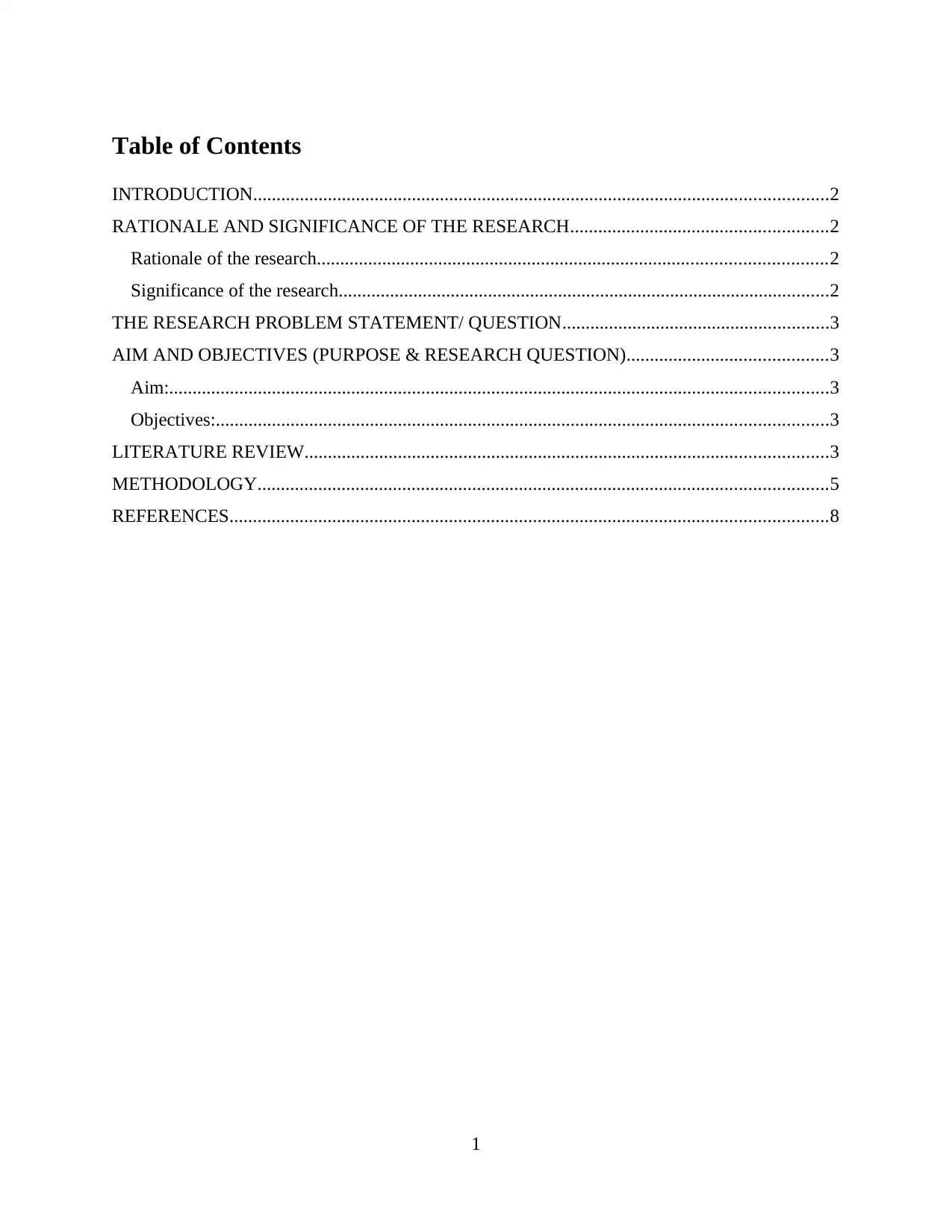
Table of Contents
INTRODUCTION...........................................................................................................................2
RATIONALE AND SIGNIFICANCE OF THE RESEARCH.......................................................2
Rationale of the research.............................................................................................................2
Significance of the research.........................................................................................................2
THE RESEARCH PROBLEM STATEMENT/ QUESTION.........................................................3
AIM AND OBJECTIVES (PURPOSE & RESEARCH QUESTION)...........................................3
Aim:.............................................................................................................................................3
Objectives:...................................................................................................................................3
LITERATURE REVIEW................................................................................................................3
METHODOLOGY..........................................................................................................................5
REFERENCES................................................................................................................................8
1
INTRODUCTION...........................................................................................................................2
RATIONALE AND SIGNIFICANCE OF THE RESEARCH.......................................................2
Rationale of the research.............................................................................................................2
Significance of the research.........................................................................................................2
THE RESEARCH PROBLEM STATEMENT/ QUESTION.........................................................3
AIM AND OBJECTIVES (PURPOSE & RESEARCH QUESTION)...........................................3
Aim:.............................................................................................................................................3
Objectives:...................................................................................................................................3
LITERATURE REVIEW................................................................................................................3
METHODOLOGY..........................................................................................................................5
REFERENCES................................................................................................................................8
1
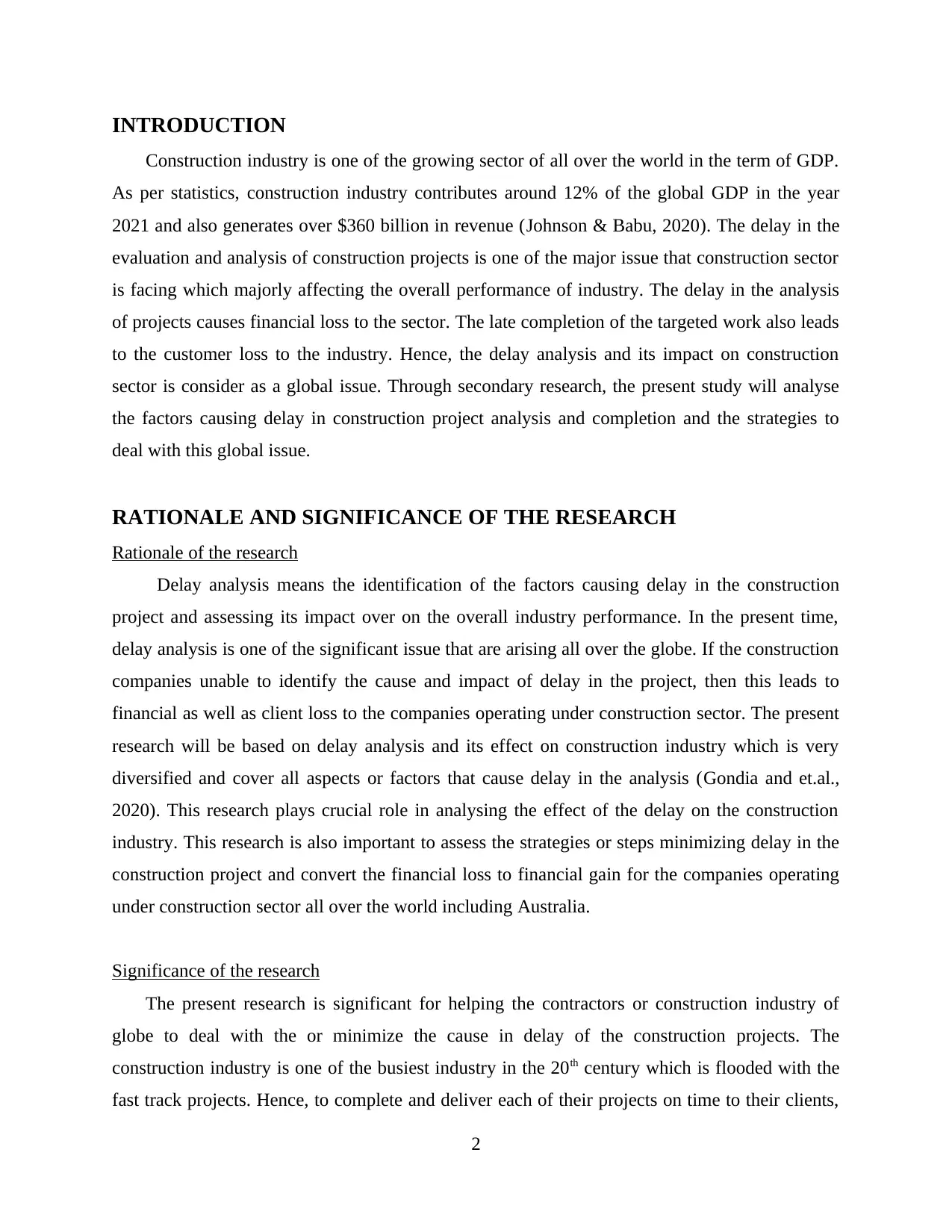
INTRODUCTION
Construction industry is one of the growing sector of all over the world in the term of GDP.
As per statistics, construction industry contributes around 12% of the global GDP in the year
2021 and also generates over $360 billion in revenue (Johnson & Babu, 2020). The delay in the
evaluation and analysis of construction projects is one of the major issue that construction sector
is facing which majorly affecting the overall performance of industry. The delay in the analysis
of projects causes financial loss to the sector. The late completion of the targeted work also leads
to the customer loss to the industry. Hence, the delay analysis and its impact on construction
sector is consider as a global issue. Through secondary research, the present study will analyse
the factors causing delay in construction project analysis and completion and the strategies to
deal with this global issue.
RATIONALE AND SIGNIFICANCE OF THE RESEARCH
Rationale of the research
Delay analysis means the identification of the factors causing delay in the construction
project and assessing its impact over on the overall industry performance. In the present time,
delay analysis is one of the significant issue that are arising all over the globe. If the construction
companies unable to identify the cause and impact of delay in the project, then this leads to
financial as well as client loss to the companies operating under construction sector. The present
research will be based on delay analysis and its effect on construction industry which is very
diversified and cover all aspects or factors that cause delay in the analysis (Gondia and et.al.,
2020). This research plays crucial role in analysing the effect of the delay on the construction
industry. This research is also important to assess the strategies or steps minimizing delay in the
construction project and convert the financial loss to financial gain for the companies operating
under construction sector all over the world including Australia.
Significance of the research
The present research is significant for helping the contractors or construction industry of
globe to deal with the or minimize the cause in delay of the construction projects. The
construction industry is one of the busiest industry in the 20th century which is flooded with the
fast track projects. Hence, to complete and deliver each of their projects on time to their clients,
2
Construction industry is one of the growing sector of all over the world in the term of GDP.
As per statistics, construction industry contributes around 12% of the global GDP in the year
2021 and also generates over $360 billion in revenue (Johnson & Babu, 2020). The delay in the
evaluation and analysis of construction projects is one of the major issue that construction sector
is facing which majorly affecting the overall performance of industry. The delay in the analysis
of projects causes financial loss to the sector. The late completion of the targeted work also leads
to the customer loss to the industry. Hence, the delay analysis and its impact on construction
sector is consider as a global issue. Through secondary research, the present study will analyse
the factors causing delay in construction project analysis and completion and the strategies to
deal with this global issue.
RATIONALE AND SIGNIFICANCE OF THE RESEARCH
Rationale of the research
Delay analysis means the identification of the factors causing delay in the construction
project and assessing its impact over on the overall industry performance. In the present time,
delay analysis is one of the significant issue that are arising all over the globe. If the construction
companies unable to identify the cause and impact of delay in the project, then this leads to
financial as well as client loss to the companies operating under construction sector. The present
research will be based on delay analysis and its effect on construction industry which is very
diversified and cover all aspects or factors that cause delay in the analysis (Gondia and et.al.,
2020). This research plays crucial role in analysing the effect of the delay on the construction
industry. This research is also important to assess the strategies or steps minimizing delay in the
construction project and convert the financial loss to financial gain for the companies operating
under construction sector all over the world including Australia.
Significance of the research
The present research is significant for helping the contractors or construction industry of
globe to deal with the or minimize the cause in delay of the construction projects. The
construction industry is one of the busiest industry in the 20th century which is flooded with the
fast track projects. Hence, to complete and deliver each of their projects on time to their clients,
2
⊘ This is a preview!⊘
Do you want full access?
Subscribe today to unlock all pages.

Trusted by 1+ million students worldwide
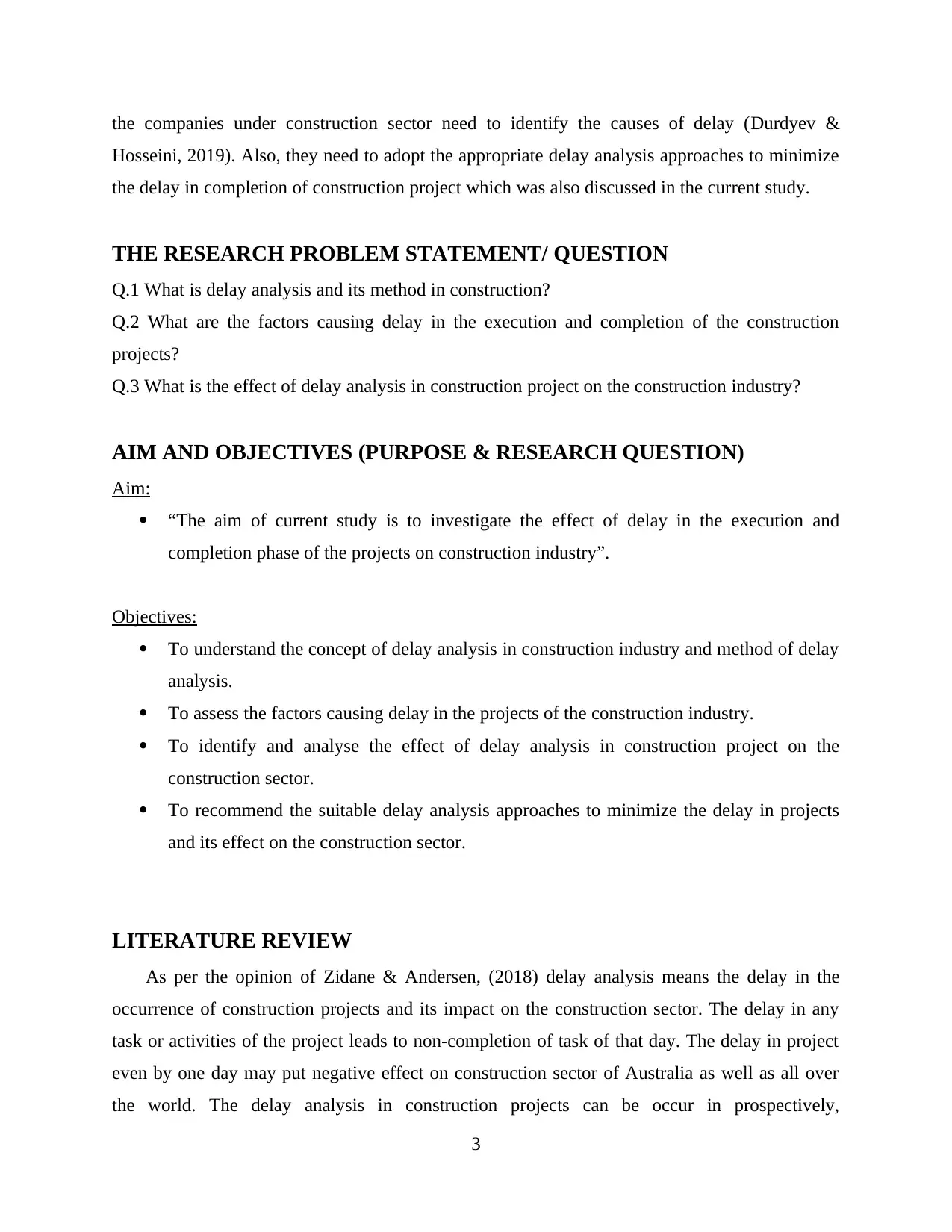
the companies under construction sector need to identify the causes of delay (Durdyev &
Hosseini, 2019). Also, they need to adopt the appropriate delay analysis approaches to minimize
the delay in completion of construction project which was also discussed in the current study.
THE RESEARCH PROBLEM STATEMENT/ QUESTION
Q.1 What is delay analysis and its method in construction?
Q.2 What are the factors causing delay in the execution and completion of the construction
projects?
Q.3 What is the effect of delay analysis in construction project on the construction industry?
AIM AND OBJECTIVES (PURPOSE & RESEARCH QUESTION)
Aim:
“The aim of current study is to investigate the effect of delay in the execution and
completion phase of the projects on construction industry”.
Objectives:
To understand the concept of delay analysis in construction industry and method of delay
analysis.
To assess the factors causing delay in the projects of the construction industry.
To identify and analyse the effect of delay analysis in construction project on the
construction sector.
To recommend the suitable delay analysis approaches to minimize the delay in projects
and its effect on the construction sector.
LITERATURE REVIEW
As per the opinion of Zidane & Andersen, (2018) delay analysis means the delay in the
occurrence of construction projects and its impact on the construction sector. The delay in any
task or activities of the project leads to non-completion of task of that day. The delay in project
even by one day may put negative effect on construction sector of Australia as well as all over
the world. The delay analysis in construction projects can be occur in prospectively,
3
Hosseini, 2019). Also, they need to adopt the appropriate delay analysis approaches to minimize
the delay in completion of construction project which was also discussed in the current study.
THE RESEARCH PROBLEM STATEMENT/ QUESTION
Q.1 What is delay analysis and its method in construction?
Q.2 What are the factors causing delay in the execution and completion of the construction
projects?
Q.3 What is the effect of delay analysis in construction project on the construction industry?
AIM AND OBJECTIVES (PURPOSE & RESEARCH QUESTION)
Aim:
“The aim of current study is to investigate the effect of delay in the execution and
completion phase of the projects on construction industry”.
Objectives:
To understand the concept of delay analysis in construction industry and method of delay
analysis.
To assess the factors causing delay in the projects of the construction industry.
To identify and analyse the effect of delay analysis in construction project on the
construction sector.
To recommend the suitable delay analysis approaches to minimize the delay in projects
and its effect on the construction sector.
LITERATURE REVIEW
As per the opinion of Zidane & Andersen, (2018) delay analysis means the delay in the
occurrence of construction projects and its impact on the construction sector. The delay in any
task or activities of the project leads to non-completion of task of that day. The delay in project
even by one day may put negative effect on construction sector of Australia as well as all over
the world. The delay analysis in construction projects can be occur in prospectively,
3
Paraphrase This Document
Need a fresh take? Get an instant paraphrase of this document with our AI Paraphraser
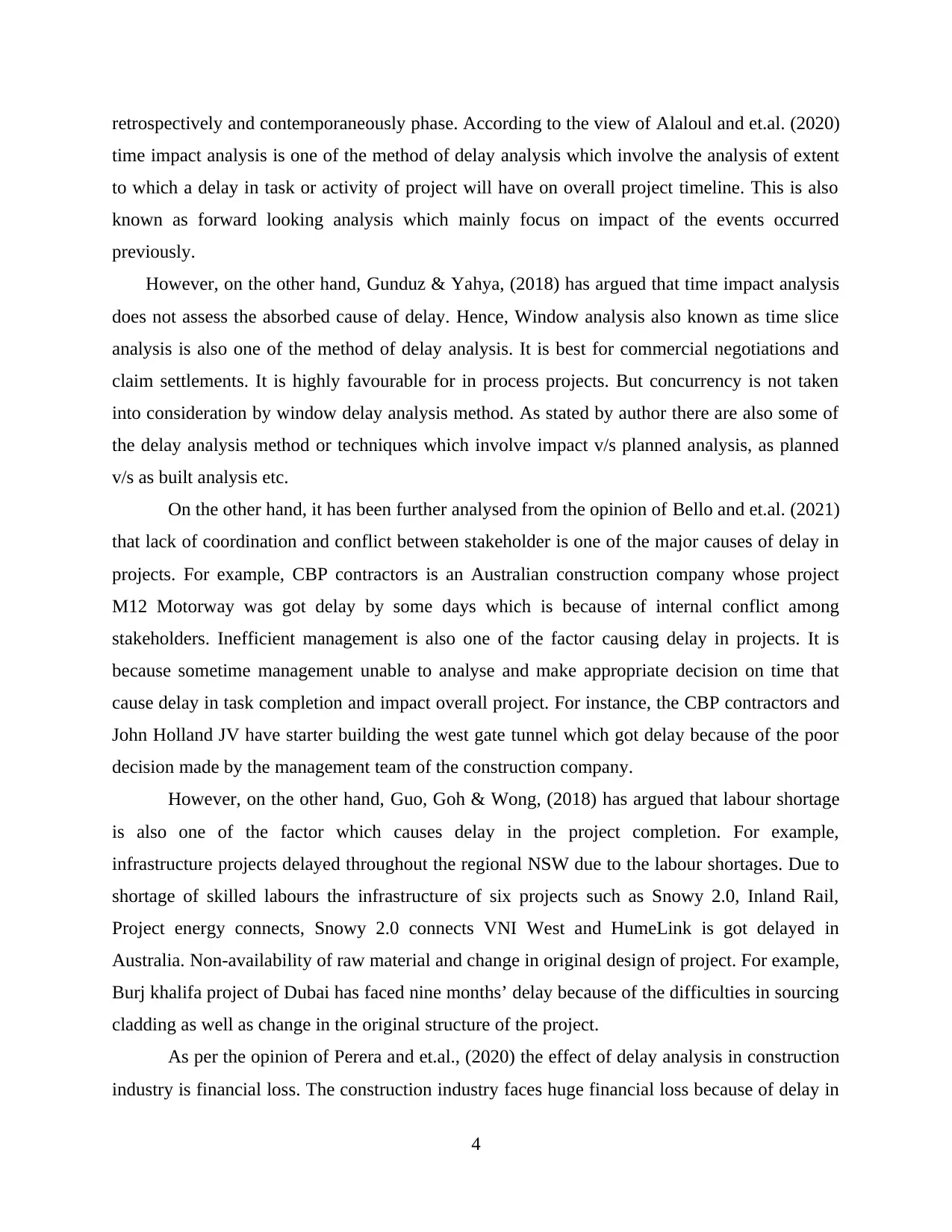
retrospectively and contemporaneously phase. According to the view of Alaloul and et.al. (2020)
time impact analysis is one of the method of delay analysis which involve the analysis of extent
to which a delay in task or activity of project will have on overall project timeline. This is also
known as forward looking analysis which mainly focus on impact of the events occurred
previously.
However, on the other hand, Gunduz & Yahya, (2018) has argued that time impact analysis
does not assess the absorbed cause of delay. Hence, Window analysis also known as time slice
analysis is also one of the method of delay analysis. It is best for commercial negotiations and
claim settlements. It is highly favourable for in process projects. But concurrency is not taken
into consideration by window delay analysis method. As stated by author there are also some of
the delay analysis method or techniques which involve impact v/s planned analysis, as planned
v/s as built analysis etc.
On the other hand, it has been further analysed from the opinion of Bello and et.al. (2021)
that lack of coordination and conflict between stakeholder is one of the major causes of delay in
projects. For example, CBP contractors is an Australian construction company whose project
M12 Motorway was got delay by some days which is because of internal conflict among
stakeholders. Inefficient management is also one of the factor causing delay in projects. It is
because sometime management unable to analyse and make appropriate decision on time that
cause delay in task completion and impact overall project. For instance, the CBP contractors and
John Holland JV have starter building the west gate tunnel which got delay because of the poor
decision made by the management team of the construction company.
However, on the other hand, Guo, Goh & Wong, (2018) has argued that labour shortage
is also one of the factor which causes delay in the project completion. For example,
infrastructure projects delayed throughout the regional NSW due to the labour shortages. Due to
shortage of skilled labours the infrastructure of six projects such as Snowy 2.0, Inland Rail,
Project energy connects, Snowy 2.0 connects VNI West and HumeLink is got delayed in
Australia. Non-availability of raw material and change in original design of project. For example,
Burj khalifa project of Dubai has faced nine months’ delay because of the difficulties in sourcing
cladding as well as change in the original structure of the project.
As per the opinion of Perera and et.al., (2020) the effect of delay analysis in construction
industry is financial loss. The construction industry faces huge financial loss because of delay in
4
time impact analysis is one of the method of delay analysis which involve the analysis of extent
to which a delay in task or activity of project will have on overall project timeline. This is also
known as forward looking analysis which mainly focus on impact of the events occurred
previously.
However, on the other hand, Gunduz & Yahya, (2018) has argued that time impact analysis
does not assess the absorbed cause of delay. Hence, Window analysis also known as time slice
analysis is also one of the method of delay analysis. It is best for commercial negotiations and
claim settlements. It is highly favourable for in process projects. But concurrency is not taken
into consideration by window delay analysis method. As stated by author there are also some of
the delay analysis method or techniques which involve impact v/s planned analysis, as planned
v/s as built analysis etc.
On the other hand, it has been further analysed from the opinion of Bello and et.al. (2021)
that lack of coordination and conflict between stakeholder is one of the major causes of delay in
projects. For example, CBP contractors is an Australian construction company whose project
M12 Motorway was got delay by some days which is because of internal conflict among
stakeholders. Inefficient management is also one of the factor causing delay in projects. It is
because sometime management unable to analyse and make appropriate decision on time that
cause delay in task completion and impact overall project. For instance, the CBP contractors and
John Holland JV have starter building the west gate tunnel which got delay because of the poor
decision made by the management team of the construction company.
However, on the other hand, Guo, Goh & Wong, (2018) has argued that labour shortage
is also one of the factor which causes delay in the project completion. For example,
infrastructure projects delayed throughout the regional NSW due to the labour shortages. Due to
shortage of skilled labours the infrastructure of six projects such as Snowy 2.0, Inland Rail,
Project energy connects, Snowy 2.0 connects VNI West and HumeLink is got delayed in
Australia. Non-availability of raw material and change in original design of project. For example,
Burj khalifa project of Dubai has faced nine months’ delay because of the difficulties in sourcing
cladding as well as change in the original structure of the project.
As per the opinion of Perera and et.al., (2020) the effect of delay analysis in construction
industry is financial loss. The construction industry faces huge financial loss because of delay in
4
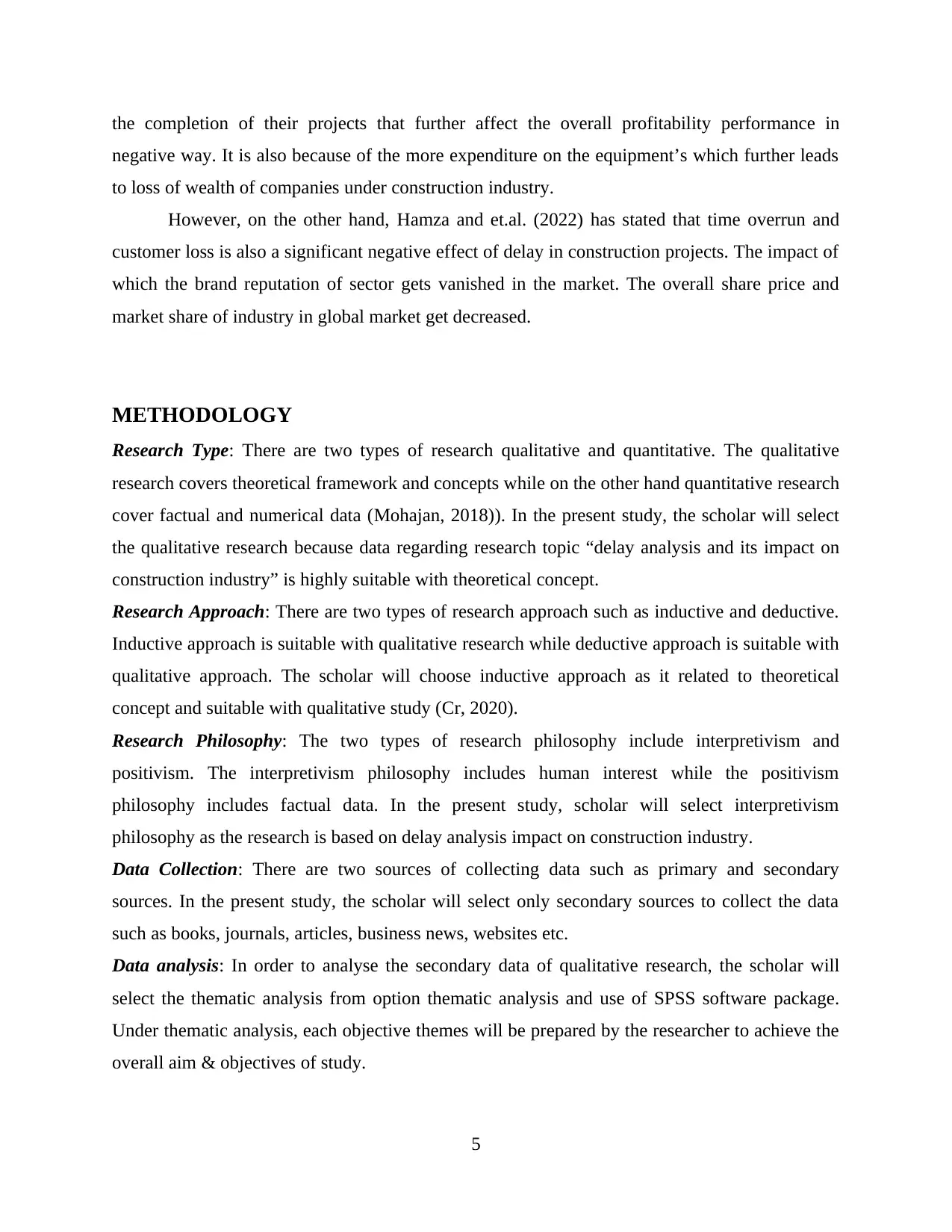
the completion of their projects that further affect the overall profitability performance in
negative way. It is also because of the more expenditure on the equipment’s which further leads
to loss of wealth of companies under construction industry.
However, on the other hand, Hamza and et.al. (2022) has stated that time overrun and
customer loss is also a significant negative effect of delay in construction projects. The impact of
which the brand reputation of sector gets vanished in the market. The overall share price and
market share of industry in global market get decreased.
METHODOLOGY
Research Type: There are two types of research qualitative and quantitative. The qualitative
research covers theoretical framework and concepts while on the other hand quantitative research
cover factual and numerical data (Mohajan, 2018)). In the present study, the scholar will select
the qualitative research because data regarding research topic “delay analysis and its impact on
construction industry” is highly suitable with theoretical concept.
Research Approach: There are two types of research approach such as inductive and deductive.
Inductive approach is suitable with qualitative research while deductive approach is suitable with
qualitative approach. The scholar will choose inductive approach as it related to theoretical
concept and suitable with qualitative study (Cr, 2020).
Research Philosophy: The two types of research philosophy include interpretivism and
positivism. The interpretivism philosophy includes human interest while the positivism
philosophy includes factual data. In the present study, scholar will select interpretivism
philosophy as the research is based on delay analysis impact on construction industry.
Data Collection: There are two sources of collecting data such as primary and secondary
sources. In the present study, the scholar will select only secondary sources to collect the data
such as books, journals, articles, business news, websites etc.
Data analysis: In order to analyse the secondary data of qualitative research, the scholar will
select the thematic analysis from option thematic analysis and use of SPSS software package.
Under thematic analysis, each objective themes will be prepared by the researcher to achieve the
overall aim & objectives of study.
5
negative way. It is also because of the more expenditure on the equipment’s which further leads
to loss of wealth of companies under construction industry.
However, on the other hand, Hamza and et.al. (2022) has stated that time overrun and
customer loss is also a significant negative effect of delay in construction projects. The impact of
which the brand reputation of sector gets vanished in the market. The overall share price and
market share of industry in global market get decreased.
METHODOLOGY
Research Type: There are two types of research qualitative and quantitative. The qualitative
research covers theoretical framework and concepts while on the other hand quantitative research
cover factual and numerical data (Mohajan, 2018)). In the present study, the scholar will select
the qualitative research because data regarding research topic “delay analysis and its impact on
construction industry” is highly suitable with theoretical concept.
Research Approach: There are two types of research approach such as inductive and deductive.
Inductive approach is suitable with qualitative research while deductive approach is suitable with
qualitative approach. The scholar will choose inductive approach as it related to theoretical
concept and suitable with qualitative study (Cr, 2020).
Research Philosophy: The two types of research philosophy include interpretivism and
positivism. The interpretivism philosophy includes human interest while the positivism
philosophy includes factual data. In the present study, scholar will select interpretivism
philosophy as the research is based on delay analysis impact on construction industry.
Data Collection: There are two sources of collecting data such as primary and secondary
sources. In the present study, the scholar will select only secondary sources to collect the data
such as books, journals, articles, business news, websites etc.
Data analysis: In order to analyse the secondary data of qualitative research, the scholar will
select the thematic analysis from option thematic analysis and use of SPSS software package.
Under thematic analysis, each objective themes will be prepared by the researcher to achieve the
overall aim & objectives of study.
5
⊘ This is a preview!⊘
Do you want full access?
Subscribe today to unlock all pages.

Trusted by 1+ million students worldwide
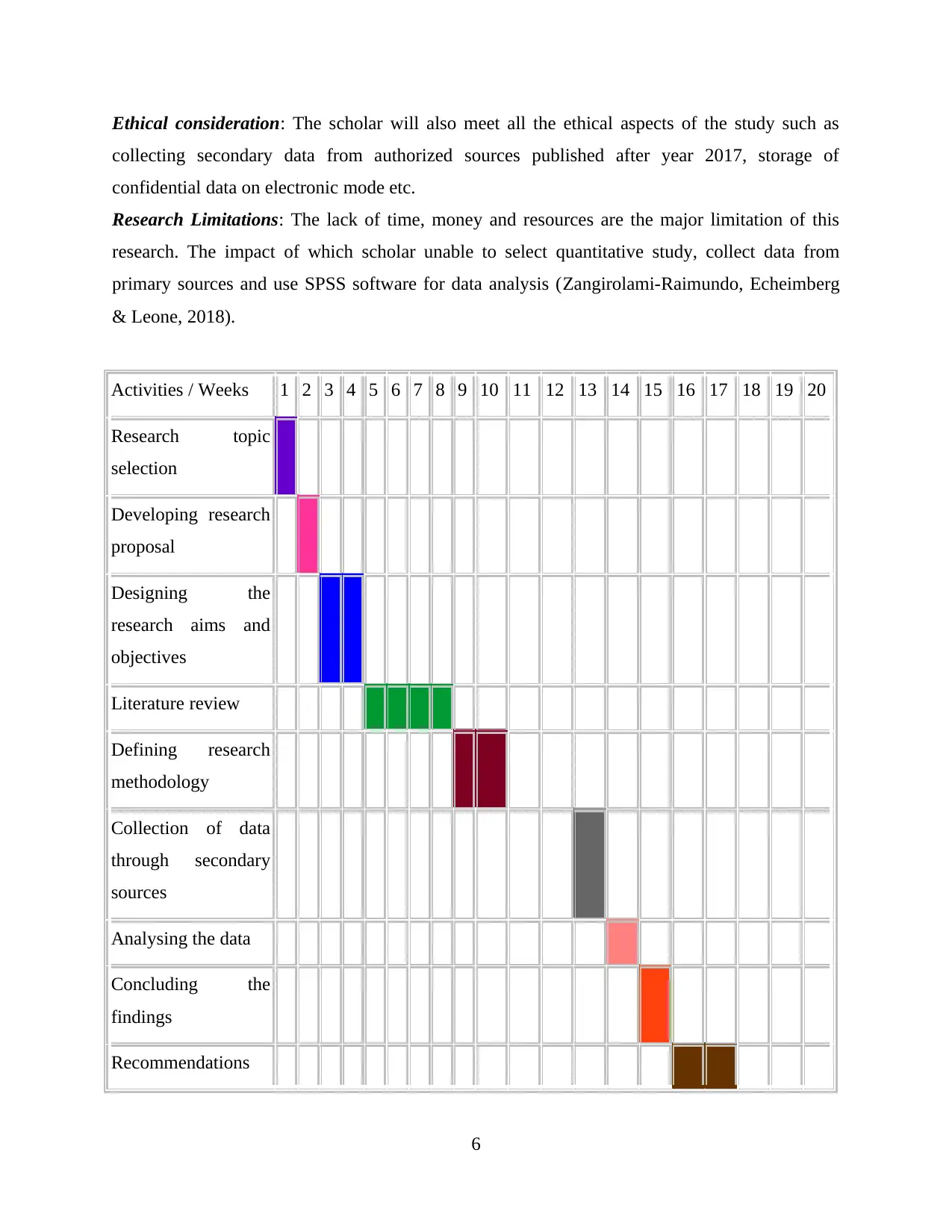
Ethical consideration: The scholar will also meet all the ethical aspects of the study such as
collecting secondary data from authorized sources published after year 2017, storage of
confidential data on electronic mode etc.
Research Limitations: The lack of time, money and resources are the major limitation of this
research. The impact of which scholar unable to select quantitative study, collect data from
primary sources and use SPSS software for data analysis (Zangirolami-Raimundo, Echeimberg
& Leone, 2018).
Activities / Weeks 1 2 3 4 5 6 7 8 9 10 11 12 13 14 15 16 17 18 19 20
Research topic
selection
Developing research
proposal
Designing the
research aims and
objectives
Literature review
Defining research
methodology
Collection of data
through secondary
sources
Analysing the data
Concluding the
findings
Recommendations
6
collecting secondary data from authorized sources published after year 2017, storage of
confidential data on electronic mode etc.
Research Limitations: The lack of time, money and resources are the major limitation of this
research. The impact of which scholar unable to select quantitative study, collect data from
primary sources and use SPSS software for data analysis (Zangirolami-Raimundo, Echeimberg
& Leone, 2018).
Activities / Weeks 1 2 3 4 5 6 7 8 9 10 11 12 13 14 15 16 17 18 19 20
Research topic
selection
Developing research
proposal
Designing the
research aims and
objectives
Literature review
Defining research
methodology
Collection of data
through secondary
sources
Analysing the data
Concluding the
findings
Recommendations
6
Paraphrase This Document
Need a fresh take? Get an instant paraphrase of this document with our AI Paraphraser
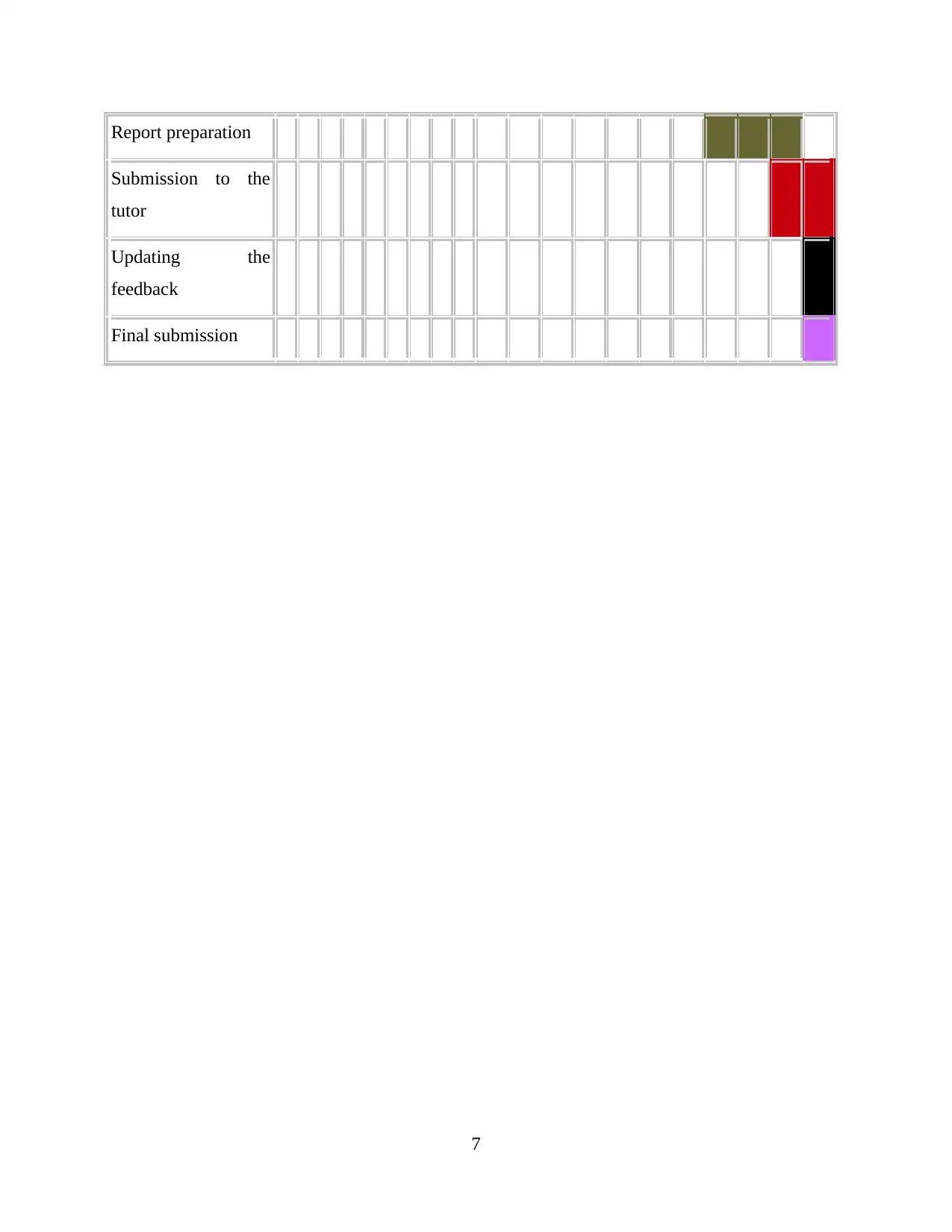
Report preparation
Submission to the
tutor
Updating the
feedback
Final submission
7
Submission to the
tutor
Updating the
feedback
Final submission
7
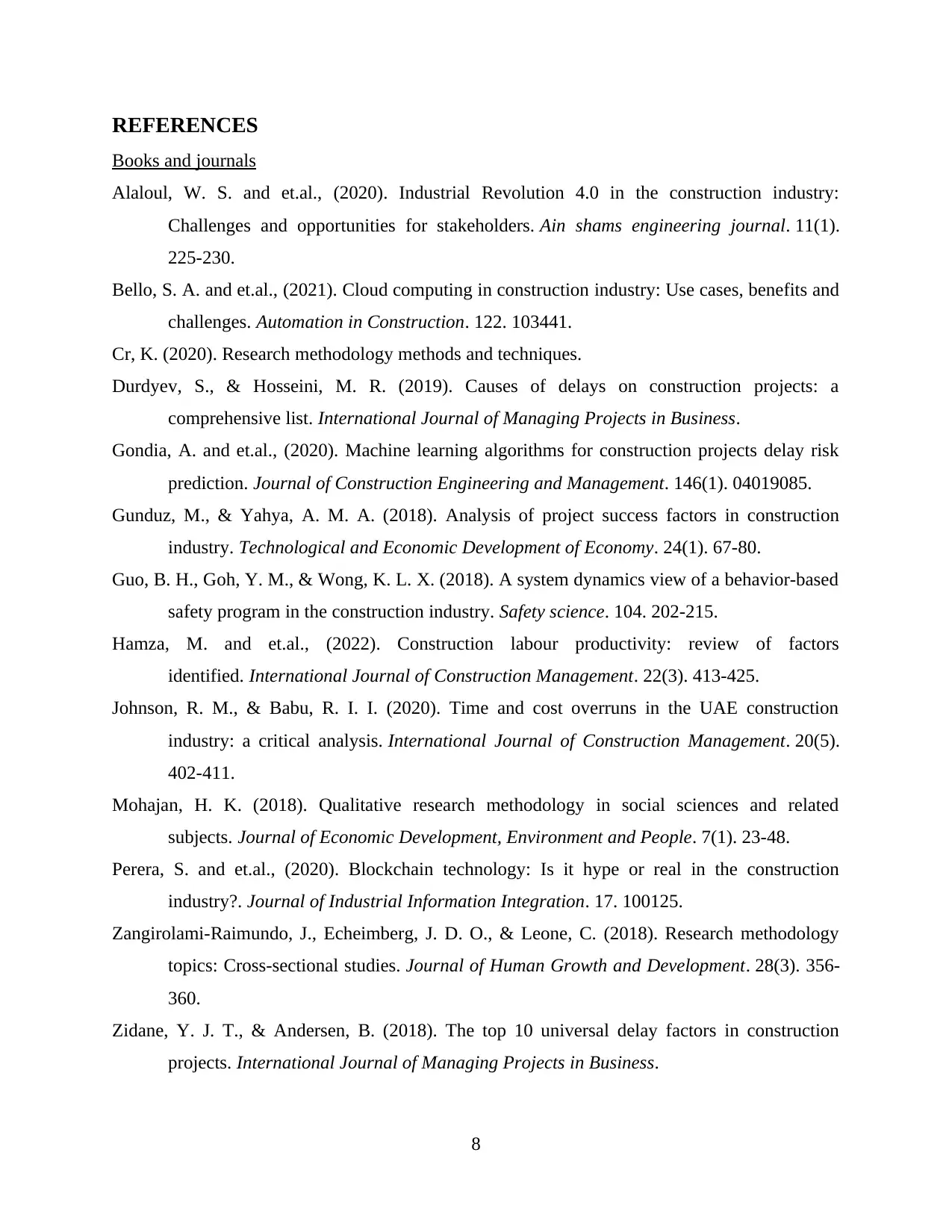
REFERENCES
Books and journals
Alaloul, W. S. and et.al., (2020). Industrial Revolution 4.0 in the construction industry:
Challenges and opportunities for stakeholders. Ain shams engineering journal. 11(1).
225-230.
Bello, S. A. and et.al., (2021). Cloud computing in construction industry: Use cases, benefits and
challenges. Automation in Construction. 122. 103441.
Cr, K. (2020). Research methodology methods and techniques.
Durdyev, S., & Hosseini, M. R. (2019). Causes of delays on construction projects: a
comprehensive list. International Journal of Managing Projects in Business.
Gondia, A. and et.al., (2020). Machine learning algorithms for construction projects delay risk
prediction. Journal of Construction Engineering and Management. 146(1). 04019085.
Gunduz, M., & Yahya, A. M. A. (2018). Analysis of project success factors in construction
industry. Technological and Economic Development of Economy. 24(1). 67-80.
Guo, B. H., Goh, Y. M., & Wong, K. L. X. (2018). A system dynamics view of a behavior-based
safety program in the construction industry. Safety science. 104. 202-215.
Hamza, M. and et.al., (2022). Construction labour productivity: review of factors
identified. International Journal of Construction Management. 22(3). 413-425.
Johnson, R. M., & Babu, R. I. I. (2020). Time and cost overruns in the UAE construction
industry: a critical analysis. International Journal of Construction Management. 20(5).
402-411.
Mohajan, H. K. (2018). Qualitative research methodology in social sciences and related
subjects. Journal of Economic Development, Environment and People. 7(1). 23-48.
Perera, S. and et.al., (2020). Blockchain technology: Is it hype or real in the construction
industry?. Journal of Industrial Information Integration. 17. 100125.
Zangirolami-Raimundo, J., Echeimberg, J. D. O., & Leone, C. (2018). Research methodology
topics: Cross-sectional studies. Journal of Human Growth and Development. 28(3). 356-
360.
Zidane, Y. J. T., & Andersen, B. (2018). The top 10 universal delay factors in construction
projects. International Journal of Managing Projects in Business.
8
Books and journals
Alaloul, W. S. and et.al., (2020). Industrial Revolution 4.0 in the construction industry:
Challenges and opportunities for stakeholders. Ain shams engineering journal. 11(1).
225-230.
Bello, S. A. and et.al., (2021). Cloud computing in construction industry: Use cases, benefits and
challenges. Automation in Construction. 122. 103441.
Cr, K. (2020). Research methodology methods and techniques.
Durdyev, S., & Hosseini, M. R. (2019). Causes of delays on construction projects: a
comprehensive list. International Journal of Managing Projects in Business.
Gondia, A. and et.al., (2020). Machine learning algorithms for construction projects delay risk
prediction. Journal of Construction Engineering and Management. 146(1). 04019085.
Gunduz, M., & Yahya, A. M. A. (2018). Analysis of project success factors in construction
industry. Technological and Economic Development of Economy. 24(1). 67-80.
Guo, B. H., Goh, Y. M., & Wong, K. L. X. (2018). A system dynamics view of a behavior-based
safety program in the construction industry. Safety science. 104. 202-215.
Hamza, M. and et.al., (2022). Construction labour productivity: review of factors
identified. International Journal of Construction Management. 22(3). 413-425.
Johnson, R. M., & Babu, R. I. I. (2020). Time and cost overruns in the UAE construction
industry: a critical analysis. International Journal of Construction Management. 20(5).
402-411.
Mohajan, H. K. (2018). Qualitative research methodology in social sciences and related
subjects. Journal of Economic Development, Environment and People. 7(1). 23-48.
Perera, S. and et.al., (2020). Blockchain technology: Is it hype or real in the construction
industry?. Journal of Industrial Information Integration. 17. 100125.
Zangirolami-Raimundo, J., Echeimberg, J. D. O., & Leone, C. (2018). Research methodology
topics: Cross-sectional studies. Journal of Human Growth and Development. 28(3). 356-
360.
Zidane, Y. J. T., & Andersen, B. (2018). The top 10 universal delay factors in construction
projects. International Journal of Managing Projects in Business.
8
⊘ This is a preview!⊘
Do you want full access?
Subscribe today to unlock all pages.

Trusted by 1+ million students worldwide
1 out of 9
Related Documents
Your All-in-One AI-Powered Toolkit for Academic Success.
+13062052269
info@desklib.com
Available 24*7 on WhatsApp / Email
![[object Object]](/_next/static/media/star-bottom.7253800d.svg)
Unlock your academic potential
Copyright © 2020–2025 A2Z Services. All Rights Reserved. Developed and managed by ZUCOL.





